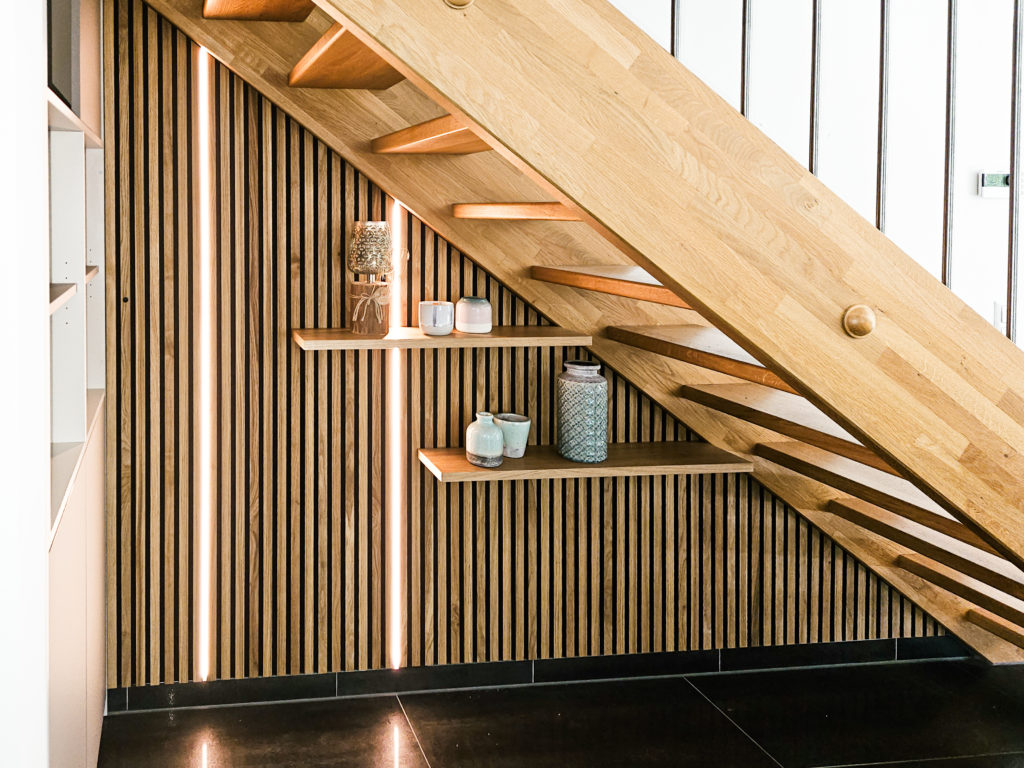Wood panelling: Everything you need to know
Wood panelling has become increasingly popular in recent years. Whether for interior design in homes and cupboards, as a decorative element or as protection for walls and ceilings, wood panelling offers a natural and aesthetic solution for many applications. In this article, you will learn everything you need to know about wood panelling: from the different types and advantages to proper care.
What are wood panels?
Wood panelling consists of flat, rectangular panels made of wood or wood-like materials and is often used for wall or ceiling cladding. It can be made of solid wood or veneer and offers a variety of surface treatments, such as natural, lacquered or glazed.
Wood panelling definition
Wood panelling consists of cladding made from natural wood or veneers and is available in various shapes and sizes. It is mainly used for decorative or functional purposes, such as to enhance the appearance of a wall or to solve acoustic problems.
Different types of wood panelling
There are many different types of wood panelling, which vary in terms of material, shape and application. Here is an overview:
- Solid wood panels: These are made of solid wood throughout and are characterised by their robust and durable structure. They offer a natural and high-quality look.
- Veneer panels: These panels consist of a thin veneer of wood that is applied to a backing board. They are often less expensive than solid wood panels, but still offer an attractive wood look.
- MDF and HDF panels: MDF (medium-density fibreboard) and HDF (high-density fibreboard) are materials made from wood fibres and synthetic resins. They are stable, easy to process and often coated or laminated to simulate a wood look.
- Laminate panels: These panels consist of a base layer and a decorative layer that imitates wood grain. They are particularly easy to care for and resistant to scratches and moisture.
Areas of application for wood panels
Wood panels are incredibly versatile. The most important areas of application are:
wall coverings
- Accent walls: Wood panelling is particularly popular for individual walls to create specific accents.
- Full wall panelling: Some rooms, such as living rooms or bedrooms, benefit from full wall panelling to achieve a consistent wood look.
ceiling coverings
Wood panelling can also be installed on ceilings to make the room appear warmer and more harmonious. Particularly in rooms with high ceilings or older buildings, wooden ceiling panelling can improve acoustics and visually reduce the height of the room.
furniture making
Wood panels are often used in furniture construction, for example for cabinet backs or shelves. They offer a robust and cost-effective alternative to solid wood and are significantly lighter.
outdoor applications
Wood panels are not only used indoors, but also outdoors, for example as façade cladding or for carports. However, it is important to ensure that special weather-resistant materials are used.
Advantages of wood panelling
Wood panelling offers numerous advantages, both aesthetic and practical:
- Natural look: Wood panelling gives rooms a warm and natural atmosphere that is difficult to replicate with other materials.
- Versatility: There is a wide range of designs, finishes and materials available, allowing wood panelling to be adapted to any interior design style.
- Easy to install: Many panels feature a click system or tongue-and-groove joints that make installation quick and easy.
- Acoustics: Wood has natural sound-absorbing properties and can help improve the acoustics in a room.
- Insulation: Wood panelling provides a certain degree of thermal and sound insulation, which can be particularly advantageous in older buildings or poorly insulated houses.
Disadvantages of wood panelling
Despite their many advantages, wood panelling also has some disadvantages that you should consider when making your choice:
- High maintenance: Depending on the type of wood and surface treatment, wood panels can be high maintenance as they need to be cleaned and treated regularly.
- Sensitive to moisture: Wood can be sensitive to moisture. Therefore, not all wood panels are suitable for use in damp rooms such as bathrooms.
- Price: High-quality solid wood panels are often expensive, especially when compared to alternatives such as laminate or MDF.
Care and cleaning of wooden panels
Proper care is essential to keep your wood panelling looking beautiful for a long time. Here are a few tips:
- Regular cleaning: Dust and dirt can be easily removed with a soft, dry cloth. For heavier soiling, you can use a slightly damp cloth, but be careful not to soak the wood.
- Care oils and waxes: Natural or oiled wood panels in particular require regular treatment with special wood oils or waxes to protect the surface and keep the wood supple.
- Protection from moisture: Avoid installing wood panelling in rooms with high humidity or direct contact with water, unless it is specifically designed for this purpose. Otherwise, the panelling may warp or swell.
Installing wood panelling: What you need to know
In most cases, installing wood panelling is a job that DIY enthusiasts can tackle themselves, especially with click or tongue-and-groove systems. However, there are a few things to bear in mind:
Tools and materials
To install wood panelling correctly, you will need some basic tools and materials:
- Saw: For cutting the panels to the appropriate length.
- Drill: If you want to attach panels to the wall that require screws or dowels.
- Mounting adhesive: Can be used to glue panels directly onto the substrate.
- Safety goggles and gloves: For your own protection when working.
The Cabinetheroes team regularly works with wood panelling, as it offers an impressive variety of uses, especially for cupboards. Whether as back panels, door panels or decorative accents, wood panelling creates a unique look and adapts to any interior design. Our experienced carpenters assemble everything with the utmost precision and cleanliness, so that your cabinet is not only functional but also a real visual highlight. Thanks to our expertise in working with wood panelling, we create customised solutions that give your living space a unique charm.
Conclusion: Why wood panelling is a good choice
Wood panelling is a versatile and aesthetic way to decorate walls and ceilings. Not only does it look attractive, it also offers functional advantages such as improved acoustics and insulation. With the right care and installation, you can enjoy it for many years to come.
If you are looking for a natural, warm and durable solution for your interior design, wood panelling could be just the thing for you.
If you would like to learn more about the different wood panels and see some of our projects, take a look at our blog post: Real wood acoustic panels as wall cladding or cabinet highlights.



